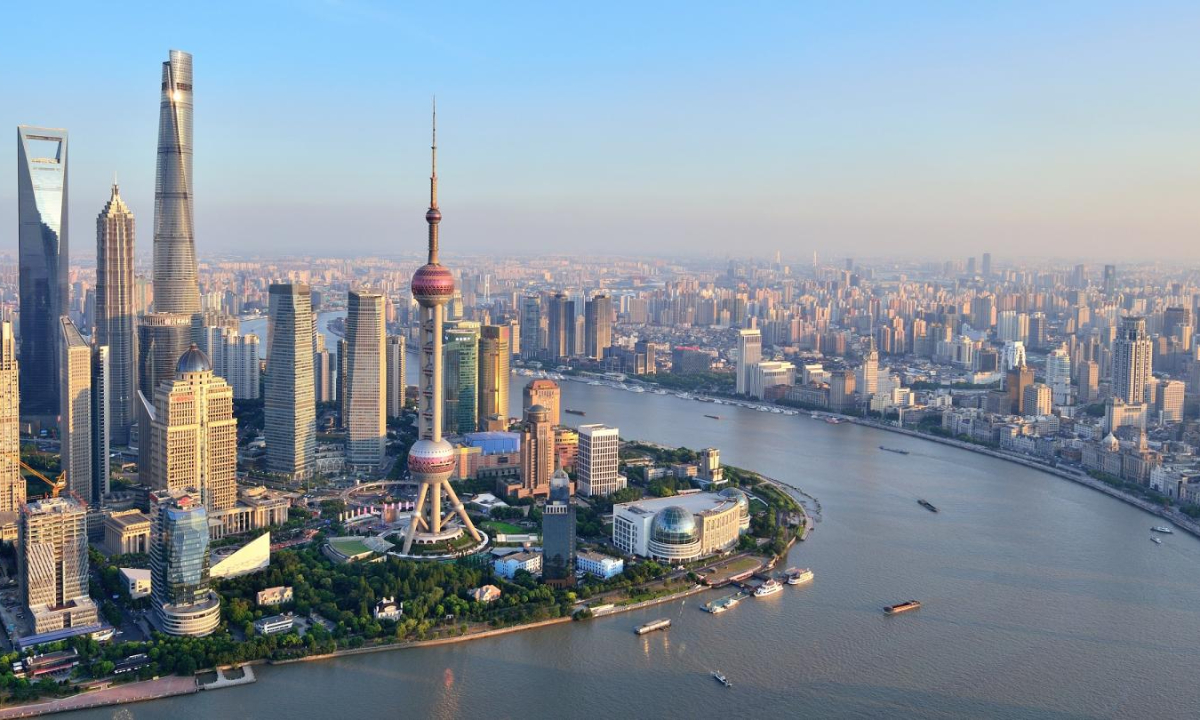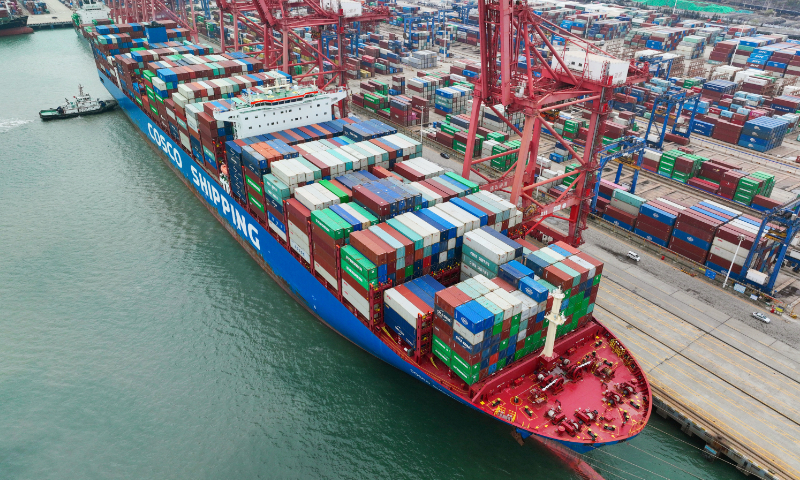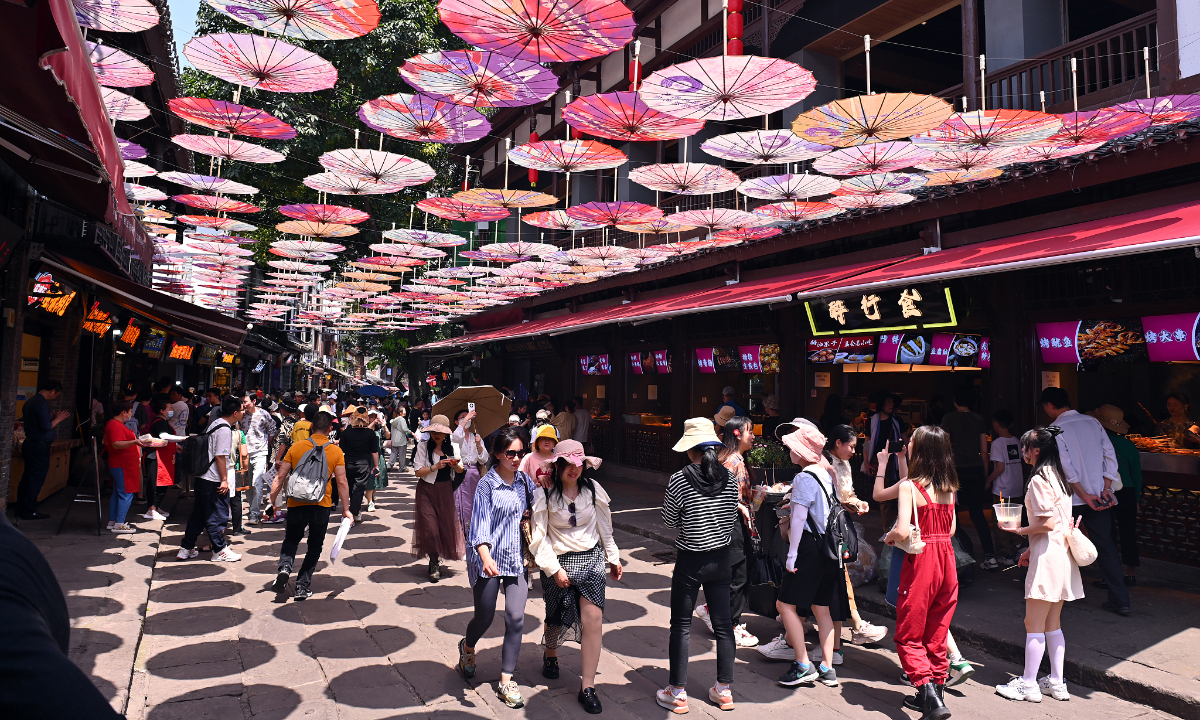
Lujiazui area in Shanghai Photo:Xinhua
A key meeting held Friday by the top decision-making body for China's financial affairs has called for speeding up the construction of the country's modern industrial system backed by the real economy and advancing Chinese modernization with support from high-quality development of the population.
Held in an important year - the first year for fully implementing the guiding principles of the 20th National Congress of the Communist Party of China (CPC), the 45th anniversary of China's reform and opening-up and the 10th anniversary of the third plenary session of the 18th CPC Central Committee - Friday's meeting is of far-reaching importance as it reaffirmed the real economy as the focal point of China's efforts in developing its economy, experts said.
Presiding over the first meeting of the commission for financial and economic affairs under the 20th CPC Central Committee, Chinese President Xi Jinping, who also heads the commission, noted that the modern industrial system is the physical and technological foundation of a modern country and offers steadfast material support for realizing the Second Centenary Goal.
Xi, also general secretary of the Communist Party of China Central Committee and chairman of the Central Military Commission, urged strategic planning and a holistic approach in realizing Chinese modernization.
Speeding up the buildup of the modern industrial system backed by the real economy will determine whether China will be able to gain a strategic lead in global competition, and the nation needs to take into consideration the new science and technology revolutionsuch as artificial intelligence and take a harmonious development approach with nature, the meeting said.
The meeting called for building smart technology-powered development, innovation, green development and integrated development and establishing a system that is integral, advanced and secure.
Friday's meeting was preceded by two other key meetings. An April 21 meeting by the top decision-making body for China's reform called for putting innovation in focus as a crucial step to achieving sci-tech self-reliance and strength and an April 28 meeting affirmed China's better-than-expected economic recovery while calling for expanding demand and a targeted "proactive fiscal policy" and "prudent monetary policy."
Experts said that bolstering post-pandemic recovery and mapping out future development is the top agenda for all countries, and China's path, due to its unique position, is deeply rooted in developing the real economy.
"In the face of the new environment, the only way to create new momentum for development is through developing high-quality real economy," Cong Yi, a professor at the Tianjin University of Finance and Economics, told the Global Times on Friday.
"Fiscal and monetary policies, the domain of the commission, will be directed to aid the still recovering economy, and financial innovation will need to stick to serving the real economy," Cong said.
"The message sent out at the meeting is clear: China won't blindly follow a Western approach to modernization by deindustrialization," Dong Dengxin, director of the Finance and Securities Institute of the Wuhan University of Science and Technology, told the Global Times on Friday.
As a country with a population of 1.4 billion, lacking a strong real economy will make the pursuit of rejuvenation a futile one, Dong said, noting that China's successful transformation and upgrade of its vast manufacturing sector served the country well during the three years of the pandemic and helped rebuke the US' decoupling efforts and crackdown.
A State Council executive meeting held on Friday called for more emphasis to be attached to forging advanced manufacturing clusters.
The meeting passed implementation guidelines to develop charging facilities across the country and promote new-energy vehicles sales in rural areas and plans on promoting rural area revitalization.

Large container ship Cosco Shipping Lotus docks at a terminal of Lianyungang port in Lianyungang, East China's Jiangsu Province on April 5, 2023. In the first quarter of this year, cargo throughput at Lianyungang port totaled 1.459 million standard containers, a year-on-year growth of 15.5 percent, official statistics showed. Photo: VCG
Robust economic growthThe Chinese economy is firing on all cylinders in the second quarter, with May Day holidays tourism brimming with vitality and rebounding above pre-pandemic levels, and a series of major trade shows and expos continuing to inject new impetus into the world's second largest economy with the dividends of opening-up.
Chinese experts noted that despite a slight slowdown in April's manufacturing purchasing managers' index (PMI) data as well as some weak links in the economy, the Chinese economy is poised to stay on the fast track in the second quarter, with the Chinese government placing further emphasis on improving the business environment and opening-up.
Banking on the explosive consumption growth seen during the just concluded five-day May Day holidays, the Chinese economy is seeing its internal drivers being constantly reinforced, experts noted. This is in stark contrast with the US, which is facing debt ceiling woes while battling high inflation.
The strong performance seen in the consumption sector came with marked results from a series of international events and trade shows held since March. At the same time, the prospect of a long list of expos and shows starting from the second quarter is set to bring uninterrupted momentum to the country's opening-up drive for the second half of the year.
The 133rd China Import and Export Fair, commonly known as the Canton Fair and one of the world's largest trade shows, concluded on Friday with on-site and online deals worth $25.11 billion inked. The trade show became a major showroom for products with new technologies, materials and processing techniques, according to Xinhua.
Just as the Canton Fair ended, China announced that the 3rd China-CEEC Expo & International Consumer Goods Fair will be held in Ningbo, East China's Zhejiang Province on May 16-20 with over 3,000 exhibitors participating in the event, up 30 percent from the previous exhibition held in 2021.
The Central and Eastern European countries (CEEC) expo will be followed by other heavyweight expos such as the China International Fair for Trade in Services to be held in Beijing in September and the China International Import Expo in Shanghai this November.
After China's optimization of its epidemic response, top executives from a host of European companies have visited the country and promoted their projects here by being "physically in China," demonstrating their resolute determination to invest in and develop their business in the country, Vice Commerce Minister Li Fei said at a press conference on Friday.
China's continued opening-up is bringing more opportunities to foreign companies, experts noted, despite hype by some Western media suggesting China is closing up with reports on topics such as "China planning to phase out global accounting firms from its market."

Tourists visit a popular tourism spot in Southwest China's Chongqing Municipality on April 16, 2023. Photo: VCG
Q2 growth to be impressiveChinese economists said although China faces issues such as uneven growth, the economy is poised to post strong growth in the second quarter with a strongly recovered consumption sector, which will contribute to much of the country's economic growth.
Cao Heping, an economist at Peking University, told the Global Times on Friday that the hot tourism market and busy succession of trade shows, which are "carnivals on the consumer-end and producer-end, will propel the economy toward a brisk growth," and predicted that China could see a GDP growth for the quarter at 5.5 percent or above.
Wan Zhe, an economist and professor at the Belt and Road School of Beijing Normal University, told the Global Times on Friday that in the next phase, further improving the business environment will play a vital role in the government's push to make further progress.
"There is a need to tap institutional power to safeguard the willingness displayed by individual market entities on consumption and willingness to pursue economic development, as shown in the prosperous tourism, retail and convention and exhibition sectors," Wan said.
In the IMF's latest forecast for the Asia-Pacific, the organization, having revised up the region's growth forecast by 0.3 percentage points to 4.6 percent, predicted that China and India will contribute around half of global growth in 2023.
China's GDP expanded by 4.5 percent in the first quarter, paving the way for a strong full-year recovery.






